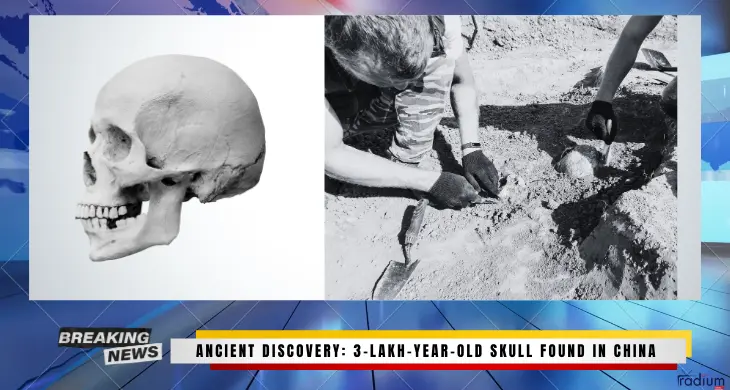The world of archaeology and anthropology has been captivated by a recent revelation – the unearthing of a 300,000-year-old skull in China. This remarkable find provides an extraordinary glimpse into the prehistoric past and offers valuable insights into our ancient human ancestors.
A 300,000-year-old ancient skull, discovered in the Hualongdong region of eastern China by an international research team, stands out as a unique find in the realm of premodern human fossils. This remarkable discovery, including the mandible or lower jaw, could potentially reshape the human family tree, suggesting a new branch. Unearthed in 2015 alongside 15 other specimens, all from the late Middle Pleistocene period, this finding sheds light on the pivotal role this era played in the evolution of hominins, including modern humans.
A study published on July 31 in the Journal of Human Evolution reveals intriguing insights. The research team’s analysis of the mandible, designated as HLD 6, indicates its “unexpected” nature, defying categorization within established taxonomic groups. This mirrors the challenge of classifying various Pleistocene hominin fossils unearthed in China, often considered anomalies. However, this recent discovery, coupled with other ongoing research, is gradually reshaping the understanding of evolutionary trends during the late Middle Pleistocene period.
HLD 6 AND ITS BLEND OF CHARACTERISTICS
Upon analyzing the HLD 6 mandible in relation to those of Pleistocene hominins and contemporary humans, the scientists discovered a combination of traits from both groups.
The HLD 6 mandible exhibits a similar shape to that of Homo sapiens, the modern human species descending from Homo erectus. However, it also shares a trait with another offshoot originating from Homo erectus, the Denisovans. Notably, like the Denisovans, HLD 6 lacks a prominent chin.
María Martinón-Torres, a study author and the director of the National Research Center on Human Evolution (CENIEH) in Spain, noted, “HLD6 does not feature a distinct chin but displays certain mildly expressed characteristics that foreshadow this common H. sapiens attribute.”
“Hualongdong represents the earliest documented fossil population in Asia displaying this combination of primitive traits and features reminiscent of Homo sapiens,” she further explained.
The researchers speculate that HLD 6 likely falls within an unnamed classification, suggesting that human-like traits might have emerged around 300,000 years ago — pre-dating the appearance of modern humans in East Asia.
Accounting for the potential influence of age on skull morphology, the team factored in the individual’s age to their analysis, considering that skull shapes can differ between juveniles and adults.
HLD 6 is thought to have been from an individual aged between 12 and 13 years. Although an adult skull of the same species was not available for direct comparison, the researchers examined skulls of comparable ages from the Middle and Late Pleistocene periods. They found consistent shape patterns irrespective of age, providing additional support for their hypothesis.
Frequently Asked Questions
Q1: What is the significance of the 3-lakh-year-old skull discovery in China?
Ans: This discovery is significant because the skull’s unique characteristics challenge existing classifications and potentially introduce a new branch in the human evolutionary tree.
Q2: Where was the skull found?
Ans: The skull, known as HLD 6, was unearthed in the Hualongdong region of eastern China.
Q3: What time period does this skull belong to?
Ans: The skull is believed to originate from the late Middle Pleistocene period, around 300,000 years ago.
Q4: How does HLD 6 differ from other Pleistocene hominin fossils found in China?
Ans: HLD 6’s features do not fit into existing taxonomic groups. It shares characteristics of both modern humans (Homo sapiens) and another branch that evolved from Homo erectus, the Denisovans.
Q5: How is the age of the individual related to the skull’s analysis?
Ans: When examining the skull, the researchers took into account the individual’s age, as skull shapes can differ between children and adults.
Q6: What implications does this discovery have for the understanding of human evolution in East Asia?
Ans: This discovery suggests that human-like traits might have existed as early as 300,000 years ago in East Asia, before the emergence of modern humans in the region.
Q7: Does this discovery lead to the creation of a new classification?
Ans: The researchers theorize that HLD 6 belongs to a yet-unnamed classification due to its distinct features and unique combination of traits.
Q8: What other factors supported the researchers’ findings?
Ans: Despite not having an adult skull of the same species for comparison, the researchers found consistent shape patterns in Middle and Late Pleistocene hominin skulls of similar ages, further supporting their hypothesis.
Conclusion
In the realm of scientific exploration, the recent discovery of the 3-lakh-year-old skull in China is a captivating chapter. This ancient artifact, with its mosaic of features, challenges our understanding of human evolution and taxonomy. The enigmatic HLD 6, belonging to a classification yet unnamed, underscores the complexity of our prehistoric origins. This revelation encourages further inquiry, as scientists strive to unravel the mysteries of our distant past and unveil the intricate pathways that led to the remarkable diversity of human life on Earth.
Stay informed with the latest updates and breaking news, brought to you by radiumnews.

